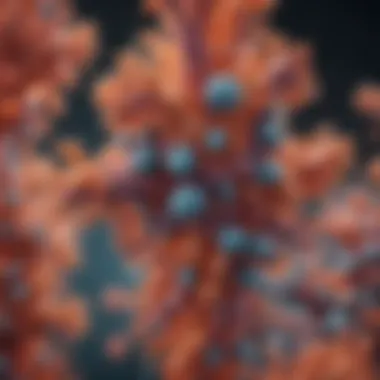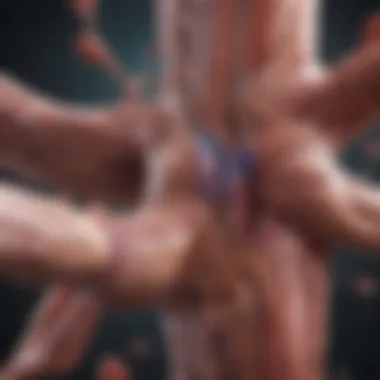Myod Antibodies: Functions and Future Perspectives


Intro
The connection between muscle biology and antibody research reveals profound implications for understanding muscular disorders. Myod antibodies provide insight into how muscle development and regeneration works, serving as crucial markers in both health and disease states. This article examines the depths of Myod antibodies, focusing on their biochemical properties, relevance in clinical applications, and potential as diagnostic tools for muscle diseases.
Research Background
Overview of the Scientific Problem Addressed
The exploration of Myod antibodies springs from a fundamental scientific inquiry: how do these antibodies influence muscle development? Myod is a transcription factor predominantly known for its role in myogenesis—the process through which muscle tissue forms. However, the intricate interplay between Myod and antibodies has remained somewhat less understood, making this an important avenue of study.
Moreover, muscle disorders such as muscular dystrophy and myopathies present significant diagnostic and treatment challenges. The presence or absence of specific Myod antibodies could offer critical insights into these diseases, bridging the gap between cellular biochemistry and clinical practice.
Historical Context and Previous Studies
Historically, research on Myod has been centered around its genetic and protein expression roles. Early studies began illustrating the importance of Myod in muscle differentiation. Yet, it wasn't until more recently that scientists started to connect Myod with antibody activity.
Some key studies have focused on how Myod antibodies interact with other cellular proteins during muscle repair. These investigations laid the groundwork for understanding the broader implications of Myod within muscle pathology, illuminating the potential for therapeutic interventions. By tracing the development of this field, we find that the integration of Myod antibodies into muscle biology is both timely and essential, marking a shift toward targeted research in muscular disease treatment.
Findings and Discussion
Key Results of the Research
Research has suggested several significant findings surrounding Myod antibodies. For example, studies indicate that the presence of certain Myod antibodies may correlate with specific muscle disorders. Interestingly, when examining muscle samples from patients, variations in these antibodies provided clues about disease progression and severity.
Interpretation of the Findings
The implications of these findings are noteworthy. If Myod antibodies can serve as reliable biomarkers for muscle diseases, clinicians could potentially enhance diagnostic precision. Accurate detection of these antibodies might allow for early intervention strategies, fundamentally altering patient outcomes.
Moreover, understanding how Myod antibodies function at the cellular level can elucidate the underlying mechanisms of muscle repair and regeneration. Further explorations in this direction could inspire innovative treatments that leverage the body's natural processes for healing.
In summary, the exploration of Myod antibodies encompasses significant facets of muscle biology, demanding attention from both researchers and clinicians. The future direction of this field promises to bring further clarity and ultimately, hope for those affected by muscular disorders.
Foreword to Myod Antibodies
Myod antibodies serve as a fascinating focus in the intersection of muscle biology and medical research. By understanding their functions, implications, and the prospects ahead, we uncover layers of knowledge that can reshape how we approach muscular disorders. The study of Myod—short for myogenic differentiation, a key regulatory factor in muscle development—opens the door to better diagnostic and therapeutic avenues for various muscle-related ailments.
At its core, the significance of Myod antibodies lies in their dual role—they not only participate in muscle development but also play a part in the pathology of muscular disorders. The notion that these antibodies could be pivotal in diagnosing conditions like muscular dystrophies or aiding in treatment strategies is not just exciting but essential in an era where precision medicine is becoming paramount.
One key consideration is the specificity of Myod antibodies. Unlike many biomarkers that might lack precision, these antibodies can be integral in pinpointing certain diseases that predominantly affect muscle tissue. This specificity could lead to more accurate diagnostic frameworks, rendering it a beneficial tool for clinicians.
Moreover, recognizing Myod antibodies brings about a deeper appreciation of the regulatory pathways involved in muscle formation and repair. Such knowledge can fuel ongoing research, paving the way for novel therapeutic strategies that harness the body’s own mechanisms to foster recovery.
This intersection of Myod antibodies with muscle biology is not merely a scientific curiosity; it has real-world implications for patients suffering from debilitating muscular disorders.
As we proceed, we will dive into the definitions and historical context surrounding Myod and its antibodies, laying the groundwork for understanding their biochemical properties and functions.


Biochemical Properties of Myod Antibodies
Understanding the biochemical properties of Myod antibodies is crucial for uncovering their roles in muscle biology and potential applications in therapeutics. These antibodies, which target Myod proteins, provide insightful information about the mechanisms driving muscle cell differentiation. This section will dive into the structural intricacies and the methods used to isolate and characterize these antibodies, shedding light on their significance in various biological contexts.
Structure and Function
The structure of Myod antibodies is tightly linked to their function. These antibodies, primarily belonging to the immunoglobulin class, are designed to recognize and bind specifically to Myod proteins. Their structural composition allows them to engage effectively with Myod, facilitating cell signaling pathways essential for muscle growth and repair.
Like most antibodies, Myod antibodies possess regions known as variable domains, which confer specificity. These domains allow for the unique recognition of Myod by forming a specific three-dimensional shape that complements the target's epitope.
In terms of function, these antibodies play a pivotal role in regulating myogenesis, the process by which muscle cells are formed. By forming complexes with Myod, they can modulate the activity of this critical transcription factor, influencing the expression of genes involved in muscle differentiation and proliferation.
Isolation and Characterization Techniques
Isolating and characterizing Myod antibodies is an essential step that assists researchers in unraveling their functional properties. Several techniques are widely used for this purpose.
- Affinity chromatography: This technique leverages the specific interactions between Myod and its corresponding antibodies. By applying a mixture of proteins to a column containing immobilized Myod, the desired antibodies can bind selectively, allowing for their eventual elution and purification.
- Western blotting: A staple method in molecular biology, Western blotting helps in confirming the presence of Myod antibodies in cell or tissue extracts. Using specific primary antibodies against Myod, researchers can visualize the proteins through secondary antibodies tagged with a reporter, providing qualitative and quantitative data.
- ELISA (Enzyme-Linked Immunosorbent Assay): This is a powerful tool often employed to measure the concentration of Myod antibodies in various biological samples. It involves solid-phase immobilization of antigens, allowing for subsequent binding and detection of the antibodies by enzyme-linked secondary antibodies.
These techniques not only help in identifying Myod antibodies but also provide grips on their quantitative profiles, essential for further functional analyses.
"Understanding the biochemical properties of Myod antibodies is not only pivotal for research but also for the potential clinical implications they hold."
Unpacking the biochemical properties of Myod antibodies offers more than academic interest. The knowledge gained can pave the way for diagnostic and therapeutic applications in muscular disorders, emphasizing the importance of ongoing research.
Role of Myod in Muscle Biology
Myod plays a crucial part in muscle biology, and understanding its role is paramount for grasping the complexities of muscle development and regeneration. As a key transcription factor, Myod directly influences the expression of genes that regulate myoblasts, the embryonic precursor cells in the formation of muscle tissue. This regulation not only impacts myogenesis, the process of muscle formation, but it also has implications in muscle repair following injury.
The intricate mechanisms surrounding Myod offer insight into muscle-related disorders, highlighting its relevance in both research and clinical settings. When we examine the role of Myod, we find that it holds a multifaceted influence over muscle growth, differentiation, and homeostasis, further establishing its foundational significance in the field of muscle biology.
Myod in Myogenesis
Myogenesis is a complex orchestration of events, where Myod acts like a conductor coordinating the symphony of muscle cell formation. This process consists of several stages, from the proliferation of myoblasts to their differentiation into mature muscle fibers. Myod initiates the myogenic program by activating the expression of muscle-specific genes.
- Proliferation Phase: In this initial phase, Myod promotes the multiplication of myoblasts. This ensures a sufficient number of cells are available for later stages.
- Differentiation Phase: As cells progress, Myod levels rise, pushing myoblasts to exit the cell cycle and commit to differentiation. This stage culminates in the fusion of myoblasts into multinucleated muscle fibers.
- Maturation Phase: Finally, during the maturation period, Myod continues to regulate muscle gene expression, ensuring that the newly formed muscle fibers develop the appropriate characteristics necessary for functionality.
Myod’s influence is not limited just to muscle formation; it also has a role in muscle regeneration post-injury. If muscle tissue is damaged, Myod is quickly activated to mobilize myoblasts for repair. Thus, the presence and activity of Myod are indispensable for both the initial muscle development and subsequent repair processes.
Regulatory Pathways Involving Myod
The activity of Myod does not occur in isolation; it is intertwined with various regulatory pathways that control muscle biology. These pathways consist of a range of signaling molecules and transcription factors that either promote or inhibit its action, enabling a finely-tuned balance essential for muscle health.
- Signaling Molecules: Key growth factors such as Sonic Hedgehog and Wnt proteins interact with Myod, shepherding it to its target genes. Their signaling can drastically influence Myod’s role in muscle differentiation.
- Other Transcription Factors: Myod does not act alone; it collaborates with other muscle-specific proteins like Myf5 and MRF4. This collaboration amplifies its effectiveness and adds layers of regulation to muscle formation.
"Myod is a crucial link in the intricate web of muscle biology, connecting numerous signaling pathways and regulatory elements. Understanding these connections is vital for deciphering muscle homeostasis and pathophysiology."
- Epigenetic Modifications: Additionally, epigenetic factors, such as histone modifications and DNA methylation, can modulate Myod’s function. These modifications dictate how accessible Myod and its associated genes are, presenting yet another layer of complexity.
- Environmental Influences: Factors such as nutrient availability and physical exercise also impact Myod activity, showcasing how external elements can shape muscle biology.


Through the understanding of these various regulatory pathways, researchers can identify potential points for intervention in muscle-related diseases, paving the way towards developing targeted therapies for conditions like muscular dystrophy or age-associated muscle loss.
Clinical Relevance of Myod Antibodies
The significance of Myod antibodies within the medical field cannot be understated. These antibodies play a crucial role in understanding muscular disorders, paving the way for more accurate diagnostics and potential therapeutic avenues. By examining the characteristics and impacts of Myod antibodies in the clinical setting, researchers and practitioners gain insights that could transform patient outcomes. The benefits of utilizing these antibodies revolve around their ability to identify specific muscular pathologies and assist in tailoring treatment strategies. With an increased focus on Myod antibodies in clinical research, there’s a wealth of potential that remains ripe for exploration.
Myod Antibodies in Muscular Disorders
Identification of Myod-related Pathologies
Identifying Myod-related pathologies is pivotal when dealing with muscular disorders. Myod antibodies serve as markers that signify the presence of muscle-related diseases, allowing for earlier diagnosis and more precise treatment plans. One of the key characteristics here is their ability to differentiate between various types of muscle disorders. This capability makes the identification process not just beneficial, but essential for clinicians who seek to establish a correct understanding of a patient’s condition.
The unique feature of these antibodies lies in their association with myogenic regulatory factors that help define muscle identity and regeneration. Their use in identifying pathologies means clinicians can target specific diseases more effectively, leading to a higher success rate in treatment. However, a drawback is that not all muscular disorders may exhibit detectable Myod antibodies, which can sometimes result in misdiagnosis or oversight, complicating clinical scenarios.
Diagnostic Applications
Diagnostic applications of Myod antibodies extend beyond their role in identifying pathologies. Their ability to provide rapid and accurate diagnostic results makes them particularly valuable. A key characteristic of diagnostic applications is their adaptability to various testing methods, including immunohistochemistry and ELISA tests. They offer a reliable means for clinicians to identify muscular disorders in diverse patient populations, which is an appealing trait in this article.
The unique aspect of diagnostic use is the potential for integration into routine testing protocols. This could fundamentally change how muscular disorders are approached in clinical settings, providing practitioners with a nuanced understanding of pathologies. However, there may be limitations when it comes to the specificity of these antibodies, as false positives can occur, necessitating confirmatory tests and re-evaluation of patient symptoms.
Therapeutic Potential of Myod Antibodies
Monoclonal Antibodies in Treatment
The use of monoclonal antibodies in treatment has gained traction, especially in the context of Myod antibodies. These highly specific antibodies can be engineered to target specific proteins involved in muscle pathology, contributing to a more personalized approach to treatment. A defining characteristic of monoclonal antibodies in this application is their ability to hone in on cellular mechanisms at play in various disorders, offering a powerful tool for intervention.
One unique feature of monoclonal antibodies is their capacity to facilitate targeted therapy, minimizing side effects associated with traditional treatment methods. This precision holds significant advantages, though it comes with the complexity of production and the need for thorough understanding of the targeted pathways. In terms of integration into practice, ongoing research is crucial to determine optimal usage.
Future Therapeutic Strategies
Considering future therapeutic strategies with Myod antibodies opens a dialogue about innovation in treating muscle-related conditions. The potential for genetic engineering to enhance the specificity or efficacy of Myod antibodies is a particularly promising area. A notable characteristic of these strategies is their forward-thinking nature, looking to harness emerging technologies for better patient outcomes.
The prospect of these strategies makes them a vital choice for advancing treatment paradigms. Unique features include the ability to combine Myod antibodies with novel delivery mechanisms, such as nanoparticles, to improve therapeutic efficacy. However, challenges remain, particularly concerning the ethical implications and potential risks involved with genetic alterations in treatment protocols. As research flourishes, addressing these complexities will be fundamental to realizing their full potential.
Exploring the clinical relevance of Myod antibodies sheds light on their multifaceted role in diagnosis and treatment, enhancing the toolkit available for healthcare providers.
As we delve deeper into the realm of Myod antibodies, it becomes evident that their clinical relevance stretches far beyond mere identification or treatment; they embody the intersection of biology and innovative medical practices.
Research Trends Involving Myod Antibodies
In recent years, the exploration of Myod antibodies has emerged as a pivotal area of research, bridging fundamental biology with practical applications in medicine. The dynamic nature of this field offers new insights, promising novel therapeutic avenues and enhanced diagnostic capabilities for muscular disorders. Emphasizing research trends, this section will detail the latest advancements, collaborative endeavors, and critical considerations surrounding Myod antibodies.
Recent Advances in Myod Research
Novel Research Findings
Recent studies have unveiled exciting discoveries offering deeper understanding of Myod antibodies' role in muscle biology. One major finding is the intricate relationship between Myod antibodies and satellite cell activation. This connection is instrumental for muscle regeneration after injury. Understanding this mechanism sheds light on potential strategies to accelerate healing in muscle injuries, a major concern in sports medicine.


A notable highlight of these findings is the increased specificity of these antibodies in detecting Myod protein in various contexts. This has not only improved the sensitivity of diagnostics for muscle-related pathologies but also advanced research methodologies. The unique feature here is the ability to distinguish between different isoforms of Myod, which can have varying implications in muscle diseases. This characteristic makes these antibodies a beneficial tool in both research and clinical settings.
Emerging Technologies
The role of technology in Myod antibody research cannot be overstated. Advances in techniques such as CRISPR gene editing and single-cell RNA sequencing are revolutionizing how researchers approach Myod-related inquiries. For instance, CRISPR has been utilized to knock out specific Myod genes, allowing scientists to observe the downstream effects on muscle development and function. The high precision of this technology is a key characteristic that makes it highly regarded in this field.
Emerging technologies also include automated imaging systems that enhance the visualization of Myod interactions in live cells. The advantages of such technologies are manifold—they provide real-time data and greater accuracy than traditional methods. However, a potential disadvantage lies in the complexity of data interpretation, which requires a certain level of expertise.
Collaborative Research Efforts
Collaboration is essential in the exploration of Myod antibodies, combining expertise from various scientific disciplines. Recent initiatives have fostered partnerships between universities, healthcare institutions, and biotechnology firms to engineer novel Myod antibodies with enhanced specificity and efficacy. These joint ventures not only accelerate research progress but also pave the way for practical applications in therapeutic interventions.
The spirit of collaboration encourages knowledge sharing, enabling researchers to tackle challenges from multiple angles. This full-circle approach enhances innovation, resulting in a cumulative understanding of the role Myod antibodies play in muscle biology.
Understanding the synergy between different fields fosters breakthroughs that can redefine therapeutic approaches to muscular disorders. This collaboration is a testament to the interconnected nature of contemporary research.
Future Directions in Myod Antibody Research
As the field of muscle biology continues to evolve, the future directions of Myod antibody research are becoming increasingly significant. Understanding these directions is not just academic; the implications stretch into therapeutic realms, facilitating the development of innovative treatments for muscular disorders. As researchers delve deeper into the complexity of these antibodies, a wealth of opportunities arise, raising questions of genetic engineering and new medical applications.
Potential for Genetic Engineering
Genetic engineering presents a promising frontier for Myod antibody research. Researchers are examining how genetic modifications can alter the expression and function of Myod-related antibodies. The potential benefits of this pursuit are substantial. Specifically, the ability to
- enhance antibody specificity
- increase efficiency in cellular uptake
- tailor therapies to individual genetic profiles
could revolutionize how muscular diseases are approached.
For instance, scientists are exploring methods to engineer Myod antibodies that target specific muscle cell types. This precision could lead to targeted therapies for conditions such as muscular dystrophy or myopathies. By tweaking the basic genetic structures of these antibodies, the hope is to improve their efficacy while mitigating side effects. Such advancements might also pave the way for personalized medicine, where treatments are tailored to the individual, ultimately improving outcomes and minimizing the adverse effects seen with more generalized therapies.
Expanding Applications in Medicine
The expanding applications of Myod antibodies in medicine are becoming a focal point for ongoing research. Initially, these antibodies have primarily been associated with muscle development and regeneration. However, their implications extend well beyond this initial understanding. They are being investigated for their roles in conditions that involve muscle atrophy, genetic muscle disorders, and even certain cancer types where muscle wasting is prominent. The versatility of myod antibodies opens the door for various therapeutic strategies.
- Regenerative Medicine: The concept of using Myod antibodies to promote muscle regeneration after injury is gaining attention. By activating satellite cells—muscle stem cells—using Myod antibodies, there's potential to significantly enhance recovery processes in injured muscles.
- Biomarkers for Disease: In addition to therapies, Myod antibodies may serve as biomarkers for early detection of muscular disorders. Identifying specific antibody profiles associated with particular diseases could lead to earlier and more accurate diagnosis.
- Combination Therapies: There’s also growing interest in combining Myod antibodies with existing treatments to boost their effectiveness. For instance, pairing antibody treatments with gene therapy could yield synergistic effects, improving patient outcomes significantly.
Such innovative exploration not only broadens the horizon of Myod antibody applications but potentially impacts a wide range of conditions beyond muscle biology, illustrating the vast potential these antibodies hold.
Culmination
The exploration of Myod antibodies takes center stage in understanding muscle biology and the implications for health and disease. As outlined throughout the article, Myod has emerged as a vital regulatory factor in muscle development, influencing not only myogenesis but also the pathways that govern muscle regeneration and repair. The presence of specific antibodies against Myod can serve as crucial biomarkers, enhancing our diagnostic capabilities for various muscular disorders.
Summary of Key Insights
- Regulatory Role: Myod is integral to myogenesis, guiding the muscle formation process during embryological development and beyond.
- Clinical Relevance: Myod antibodies show meaningful correlations with muscular disorders, providing insight for potential diagnostic tests that may facilitate early intervention.
- Therapeutic Strategies: The potential for developing monoclonal antibodies targeting Myod opens new avenues for treatment strategies, signaling a shift towards precision medicine in muscular disease management.
- Research Trends: The ongoing research highlights advancements and collaborative efforts aimed at unraveling the complexities of Myod interactions, which could reshape understanding in both basic and clinical medicine.
"The more we understand Myod antibodies, the closer we get to devising effective treatments for conditions that have long been challenging to manage."
Call for Continued Research
While significant strides have been made in the study of Myod antibodies, much lies ahead. The intricacies of their functions and interactions with various cellular pathways necessitate further exploration. Emphasis should be placed on:
- Investigating the molecular mechanisms that underpin Myod’s role in different muscle-related conditions.
- Expanding clinical trials to ascertain the efficacy of Myod antibodies in diverse therapeutic settings.
- Collaborating across disciplines, from basic research to clinical application, to foster comprehensive understandings that can lead to breakthroughs.
In summation, the discourse on Myod antibodies not only signifies their potential in addressing muscle diseases but reflects a broader call within the scientific community. Researchers, clinicians, and even educators must collaborate, challenging existing paradigms and paving the way for innovative solutions to longstanding health issues.







